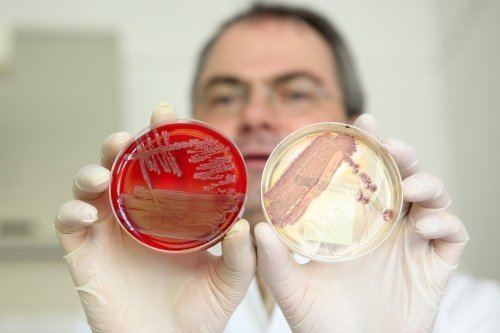A Korean woman was infected in 2004 with supposedly the same strain of E. coli bacteria that has killed 19 people and sickened about 1,600 in Europe, two Korean doctors said on Sunday.
The 29-year-old patient was treated for what would be the first known case of the so-called EHEC 0104 infection, they said.
The doctors -- Professors Bae Yoo-kyun at Chonnam National University Hwasun Hospital and Jang Hee-chang at Chonnam National University Hospital – reported the case in a Korean medical journal in 2006.
The current E.coli outbreak is the deadliest in modern history. More than 1,700 people in Germany have been sickened, including 520 suffering from a life-threatening complication that can cause kidney failure, according to the Associated Press.

Helmut Fickenscher, director of the institute for infection medicine at the university clinic of Schleswig-Holstein, holds petri dishes with colonies of the virulent E.coli bacteria on Wednesday at the insitute’s laboratory in Kiel, northern Germany. (AFP-Yonhap News)
Ten other European nations and the U.S. have reported 90 other cases, all but two related to visits in northern Germany.
The Korean professors said the 29-year-old woman was hospitalized in August 2004 after suffering stomach pains and internal bleeding.
She was diagnosed with hemolytic-uremic syndrome (HUS), which is normally caused by enterohemorrhagic E. coli (EHEC) O157:H7. But doctors later found a different strain, E. coli O104:H4, in her stool sample.
She was released after four weeks of treatment.
"The patient had eaten a hamburger and first she was treated for diarrhea," Bae said. "Her symptoms got worse, and they were more serious than usual symptoms for typical E. coli infection."
They reported the case in the Yonse Medical Journal in 2006. It was the first paper that claim that the EHEC O104 strain could also cause HUS.
"No major research on E. coli followed that paper," Jang said. "And there's not been any outbreak before the recent one in Europe."
Jang said he would have to compare the Korean case with other E. coli cases.
“There are different kinds of O104:H4 and they seem to have particular genes that cause HUS," the professor said.
The elusive source of killer bug is still puzzling European authorities.
German media reported Saturday that 17 persons fell ill with E. coli after they ate in the northern German city of Luebeck last month, and that researchers from Germany's national disease control center were inspecting the restaurant.
Other media said health experts were investigating whether the disease first spread at a festival in the northern city of Hamburg last month that was visited by 1.5 million people.
Those sickened at the Luebeck restaurant included eight women who participated in a workshop in the city, a group of tourists from Denmark and a child from southern Germany.
``The restaurant is not responsible for this, however by looking at their delivery companies, we may be able to find out how and from where the bacteria spread,'' Werner Solback, a microbiologist from the university hospital in Luebeck, was quoted as telling the Luebecker Nachrichten paper.
The news magazine Focus reported Saturday that the first patients were hospitalized a week after the Hamburg festival and said the national disease control center, the Robert Koch Institute, assumes that many people likely were infected there. The institute has not discussed this theory and could not be reached for comment Saturday.
German Health Minister Daniel Bahr, meanwhile, warned Saturday that the cause of the infection may still be active.
“We have to continue to be alert,'' Bahr told daily paper Ruhr Nachrichten. ``Health officials are working nonstop to find the cause for all the infections, however, from outbreaks in the past we know that often the cause cannot be clearly identified.'' (From news reports)
<한글 기사>
장출혈성대장균 2004년 한국서 발병
29세 여성 장출형성대장균(O104:H4) 감염, 치료 후 완치
올해 유럽 발병 이전 세계 유일 사례
(광주=연합뉴스) 장덕종 기자 = 독일을 중심으로 유럽에 확산되고 있는 장출혈성 대장균(EHEC 0104:H4) 환자가 2004년 한국에서도 발생했던 것으로 확인됐다.
5일 화순전남대병원 배우균 교수와 전남대병원 장희창 교수에 따르면 2004년 8월 심한 복통과 설사, 혈변 증세를 보인 29세 여성이 병원에 후송돼 왔다.
당시 이 환자는 급성 신부전 증세와 용혈성 빈혈, 혈소판 감소증을 보여 치명적합병증인 용혈성요독증후군(HUS) 진단을 받았으며, 대변에서 O104:H4 대장균이 검출됐다.
이 환자는 혈장교환과 혈액투석 치료 등을 받고 4주 후 완치했다. 배 교수는 이 환자의 사례를 바탕으로 O104:H4 관련 논문을 썼고, 이 논문은 2006년 '연세 메디컬 저널'에 게재됐다.
배 교수는 "당시 환자는 햄버거를 먹고 복통과 설사가 심해 치료를 받다가 설사까지 심해지고 소변도 나오지 않아 병원으로 이송됐다"며 "기존에 알려진 대장균 감염 증상보다 심각했었다"고 말했다.
이 사례가 O104:H4 발병으로는 세계 최초인 것으로 알려지면서 학계 등의 비상한 관심을 끌고 있다.
장 교수는 "대장균은 여러가지인데 용혈성요독증후군을 일으키는 원인이 0157이아닌 0104도 일으킬 수 있음을 세계 최초로 논문으로 보고한 사례"라며 "이후 이 대장균에 대한 특별한 조사가 이뤄지지 않았고 이번 유럽에서의 발병 이전에는 보고된사례가 없었다"고 설명했다.
그는 희귀변종일 가능성에 대해서는 "이전 대장균 발병 사례 등과 유럽에서의 환자들과도 비교를 해봐야 할 것 같다"면서 "O104:H4에도 여러 종류가 있는데 항생제 내성을 지니고 용혈성요독증후군을 일으키는 특정 유전자를 갖고 있는 것 같다"고 분석했다.
유럽에 확산되고 있는 장출혈성 대장균(O104:H4)은 독성이 매우 강한 시가(shiga) 독소에다 장(腸)의 벽에 달라붙을 수 있는 특이한 아교질(glue)을 지니고 있는 희귀변종인 것으로 밝혀졌다.

![[AtoZ into Korean mind] Humor in Korea: Navigating the line between what's funny and not](http://res.heraldm.com/phpwas/restmb_idxmake.php?idx=645&simg=/content/image/2024/04/22/20240422050642_0.jpg&u=)

![[Exclusive] Korean military set to ban iPhones over 'security' concerns](http://res.heraldm.com/phpwas/restmb_idxmake.php?idx=645&simg=/content/image/2024/04/23/20240423050599_0.jpg&u=20240423183955)

![[Herald Interview] Why Toss invited hackers to penetrate its system](http://res.heraldm.com/phpwas/restmb_idxmake.php?idx=645&simg=/content/image/2024/04/22/20240422050569_0.jpg&u=20240422150649)
![[Graphic News] 77% of young Koreans still financially dependent](http://res.heraldm.com/phpwas/restmb_idxmake.php?idx=645&simg=/content/image/2024/04/22/20240422050762_0.gif&u=)